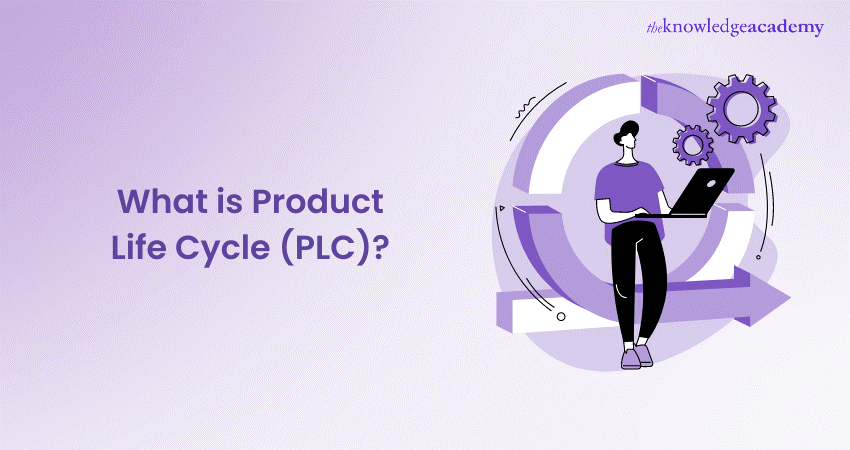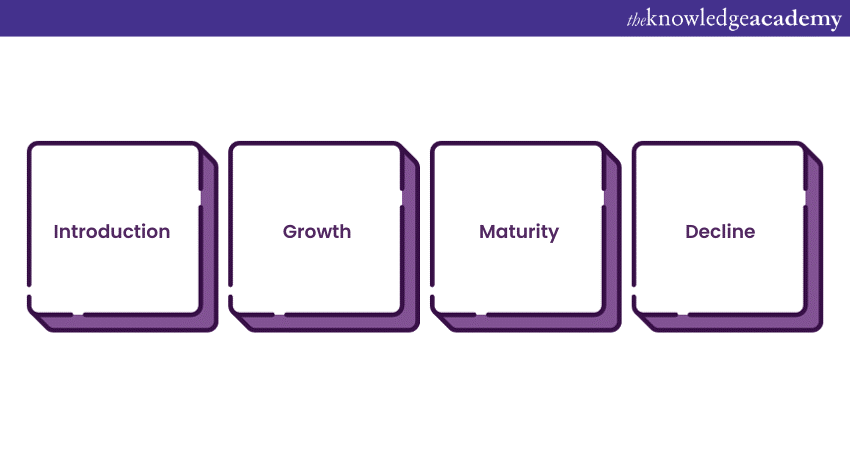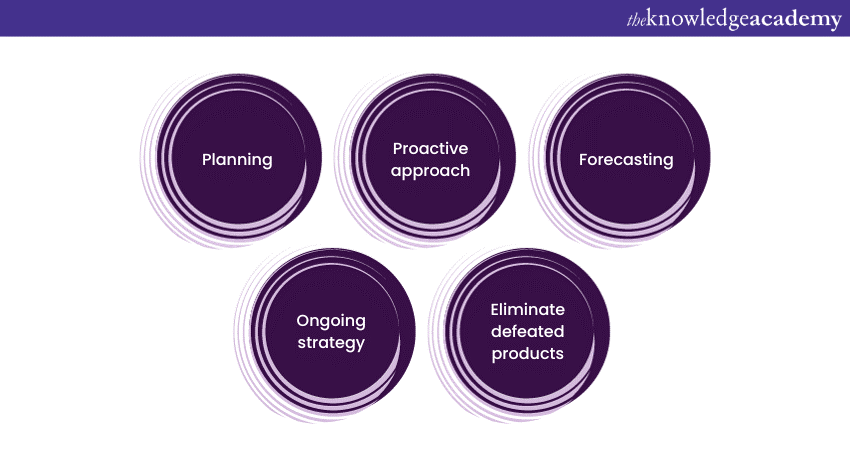We may not have the course you’re looking for. If you enquire or give us a call on 01344203999 and speak to our training experts, we may still be able to help with your training requirements.
Training Outcomes Within Your Budget!
We ensure quality, budget-alignment, and timely delivery by our expert instructors.

In the world of product development, shipping and monitoring, Product Life Cycle is something that is monitored on a frequent basis. But What is Product Life Cycle? Well, if you’re someone who’s keen on understanding the way a product is created, tested and delivered, then this blog is for you. Read this blog to gain an understanding of the concept of Product Life Cycle.
Table of contents
1) Understanding Product Life Cycle
2) Four stages of the Product Life Cycle
3) Characteristics of Product Life Cycle stages
4) Importance of Product Life Cycle
5) Limitations of Product Life Cycle
6) Types of Product Life Cycle
7) Conclusion
Understanding Product Life Cycle
The term Product Life Cycle defines the duration of time when the Product is launched into the market and introduced to the customers until it’s taken out from the shelves. This process involves management and the marketing professionals deciding on the right time to increase the promotion, reduce prices, expand into other markets or rework packaging of the said Product. In other words, the Product Life Cycle is a procedure of strategising the methods to constantly support and maintain the Product.
Product Life Cycle consists of four stages, introduction, growth, maturity and decline. A company frequently experiences higher costs of marketing when launching the Product into the market but also gets higher sales because of growth in Product adoption. The concept of Product Life Cycle assists companies in making informed business decisions, such as pricing, advertisement, expansion and cost-cutting.
Four stages of the Product Life Cycle

As mentioned in the image above, every Product Life Cycle revolves around four stages- introduction, growth, maturity and decline. Usually, each stage in the Product Life Cycle delivers a different set of opportunities for marketing that directly or indirectly affects the Product sales. Let's understand each stage in detail:
Introduction stage
The introduction stage is the stage when the Product is introduced to the customer or launched in the market for the first time. In this stage, the company usually includes significant investment in promotion and advertising campaigns aimed at making the customers aware of the Product and its advantages, specifically when they are broadly unfamiliar with what the Product will do. At the time of the introduction stage, there is very low competition for the Product, as competitors may just be introducing the first look of the new Product. However, companies still frequently incur negative financial outcomes at the introduction stage as sales are likely to decrease, or advertising pricing may be less to consumer engagement.
Growth stage
If the Product is booming, then it moves to the growth stage. This is distinguished by increasing demand, increased Production, and expansion in availability. The quantity of time invested in the introduction stage before a company's Product experiences substantial growth will differ between Products and industries.
At the time of the growth stage, the Product becomes more famous and noticeable. A company may still invest laboriously in advertising if the Product experiences rich competition. Yet, marketing campaigns will likely be adapted towards differentiating its Product from others instead of introducing the goods to the market. A company may refine its Product by enhancing functionality according to customer feedback. Financially, the growth stage of the Product Life Cycle leads to an increase in sales and higher revenue. Competition grows as it offers rival Products, potentially pushing the company to reduce prices and incur lower margins.
Maturity stage
The maturity stage is the most profitable stage of the Product Life Cycle. It is the time when the costs of producing and marketing are reduced. In this stage, the market is saturated with Products, competition at other stages gets higher, and the net profit starts to diminish. Based on the resources, a company may start to decide how to innovate its Product or introduce new methods to grab a more prominent market presence. This includes acquiring more customer feedback and analysing their demographics and requirements.
At the time of maturity stage, the level of competition is high. Competitor companies have had sufficient time to introduce competing and improved Products; customer competition is usually highest at that time. Sales levels are balanced, and a company aims to have its Product in this maturity stage for as long as possible.
Decline stage
Now, it's time to decline in the Product Life Cycle. In this stage, when the Product faces increased competition as other competitor companies simulate its success, the Product may experience a loss of market share and start declining. The sales of Products start dropping because of market saturation and other Products. Then, the company chooses not to give an additional effort in marketing as consumers may already know whether they trust the company's Product or not. Alternatively, the company may update the Product or present a next-generation Product that is completely overhauled model. If the advancement is substantial enough, the company may re-enter the Product Life Cycle by launching a new version in the market.
According to the marketing terminologies, these four stages of the Product Life Cycle affect the changing pattern of the Product’s sales and market share over the period of time.
Learn the basic concepts of Product management with our Product Management Training Course now!
Characteristics of Product Life Cycle stages
Let’s have a better understanding of each stage of the Product Life Cycle with their characteristics.
|
Characteristics |
Introduction |
Growth |
Maturity |
Decline |
|
Marketing objective |
Attract more innovators and opinion leaders towards new Product |
Enlarge Product line and distribution |
Keeps the differential advantage maintained for a long period of time |
Terminate or revamp the Product |
|
Industry sales |
Increasing |
Rapidly increasing |
Stable |
Declining |
|
Competition |
Very low |
Moderate |
High |
Limited |
|
Industry profit |
Negative |
Increasing |
Decreasing |
Decreasing |
|
Customers |
Innovators |
Affluent mass market |
Mass market |
Laggards |
|
Product Mix |
One or two basic models |
Expanding line |
Full Product line |
Bestsellers |
|
Distribution |
Depends on Product |
Increasing number of outlets |
Substantial number of outlets |
Reducing the number of outlets |
|
Promotion |
Informative |
Persuasive |
Competitive |
Informative |
|
Pricing |
Depends on Product |
High range of price |
Full line of price |
Selected price |
Want to increase productivity, employability and customer satisfaction, then take a look at our Industry Training today!
Importance of Product Life Cycle

Now, let’s move on to the importance of the Product Life Cycle. Here are the following key points which explain the importance of the Product Life Cycle.
1) Planning
2) Proactive approach: It assists the organisation in planning out practical strategies for improving sales and profits at every phase instead of just waiting and watching for the fall of the Product. Let's take an example- in case the organisation can make out that the Product has started experiencing decline, its endeavour can be on clearing the unprofitable delivery media for bringing down the cost as the sales and earnings are continuously falling.
3) Forecasting: A Product Life Cycle approach assists the organisation in forecasting, which ultimately supports them in exploring the complex market. It delivers insight to the planning authorities while forecasting the Product's future on a macro level or broader level. It also allows the organisation to take convenient steps while executing tactics against competitors.
4) Ongoing strategy: A Product Life Cycle model can act as an instrument that can authenticate the ongoing strategy as it can show the ongoing market trends, technological advances, and customer requirements and concerns. Organisations always need to be ready to deal with new and old competitors in the market; for this, they need to boost their Product's positioning to gain a competitive benefit over their competitors. This can be executed with the support of PLC.
5) Eliminate defeated Products: It is the fact that every Product eventually fades and can’t bring any profit. Products like these prove to be a load for the organisation. The Product Life Cycle model helps organisations eliminate such types of Products by deciding the suitable time for the elimination.
Register at our Logistics Management Training Course now and understand the Product design for environmental and sustainable logistics.
Limitations of Product Life Cycle
Here are the following limitations of the Product Life Cycle which you may encounter while using this approach.
1) Fluctuations and delays in sales data: The Product Life Cycle operates based on sales data for forecasting and analysis, which tends to be delayed, fluctuated, or unavailable. These types of occurrences can affect the predictions and make them inaccurate.
2) Not applicable for all services and Products: The Product Life Cycle approach is not applicable for certain brands and services, such as computer software and mobile networks, as these services and brands keep changing and need frequent updates.
3) Market conditions may differ: The market conditions of different regions may differ because of that; it gets very hard to learn from the previous life cycle of the Product. There are Products that move at a very fast pace in some areas and some Product that moves at a very slow pace because of varying consumption criteria.
4) Restrictions in decision-making: If the Product Life Cycle operates on inaccurate data, it may affect informed decision-making and ultimately lead to an inappropriate course of action, including comprehensive marketing and expansion or premature Product exit. You may encounter such situations when there is inadequate data for comparison, and this needs flexibility in embracing effective techniques to rescue situations.
Types of Product Life Cycle
Let’s understand the types of Product Life Cycle
1) Traditional PLC curve: In this type of curve, we can clearly see the different stages of the Product. In other words, the traditional PLC curve clearly portrays the introduction, growth, maturity and decline stages of the Product.
2) Classic PLC curve: In the classic PLC curve, firstly, the curve indicates a massive increase in sales and then a plateau-like shape is formed, which indicates that the sales volume has stopped rising due to the reduction in the number of new consumers or new sales channels.
3) Fashion fad PLC curve: There are specific Products whose speed of acquiring and losing popularity in the market is almost the same. These types of Products form fashion fad PLC curves. There are some examples of such Product, which includes toys and garments on the theme of Vodafone's Zoozoos, authorised jerseys during the Cricket World Cup, etc., in which the Products abruptly earn too much favour but drop down at the same pace as well.
4) Extended fashion fad PLC curve: This PLC curve is similar to the above-mentioned fashion fad PLC curve. There is only one difference between both curves: in this PLC curve, the growth of the sales does not reduce completely. Instead, it gets stability at a certain level.
5) Seasonal or fashion PLC curve: In this type of PLC curve, there is a particular season for the Products in which its sales level boosts, and as soon as the season finishes, its sales curve also falls down. The best example of such Product is school uniforms, whose demand increases at the time of the new session, after that, it falls down in the middle of the session, and it again increases with the beginning of the winter season.
6) Revival PLC curve: This PLC curve is related to such types of Products which are old-fashioned and have lost their popularity completely, but suddenly their trend or popularity seems revived.
Conclusion
We hope now you have understood the whole concept of the Product Life Cycle. In this blog, we have covered almost everything about the Product Life Cycle, such as What is the Product Life Cycle, the characteristics of the Product Life Cycle stages, the importance of the Product Life Cycle, the limitations of the Product Life Cycle and more. The approach of the Product Life Cycle is essential for almost all types of organisations as it gives a better understanding of how to utilise the resource in the best way, what will be the future outlook of the Product and how to plan and implement the strategies in the best way.
Check out our SCADA Training Course now!
Frequently Asked Questions
Upcoming Business Skills Resources Batches & Dates
Date
 Facilitation Skills Training
Facilitation Skills Training
Fri 21st Jun 2024
Fri 2nd Aug 2024
Fri 18th Oct 2024
Fri 20th Dec 2024







 Top Rated Course
Top Rated Course



 If you wish to make any changes to your course, please
If you wish to make any changes to your course, please


